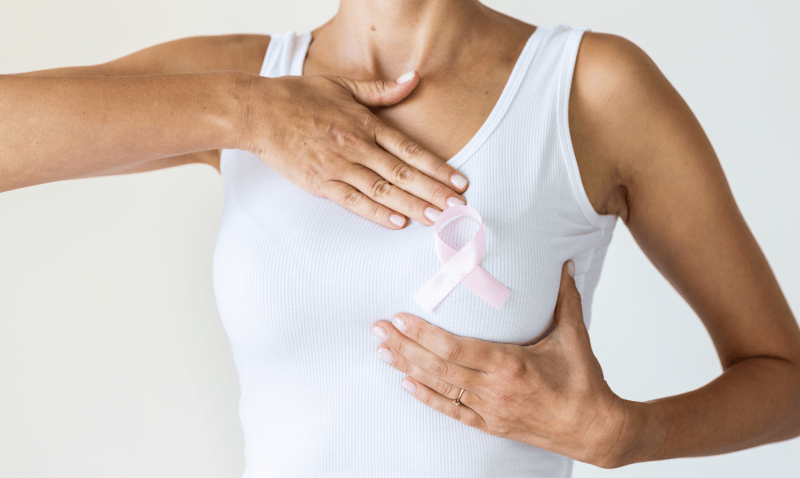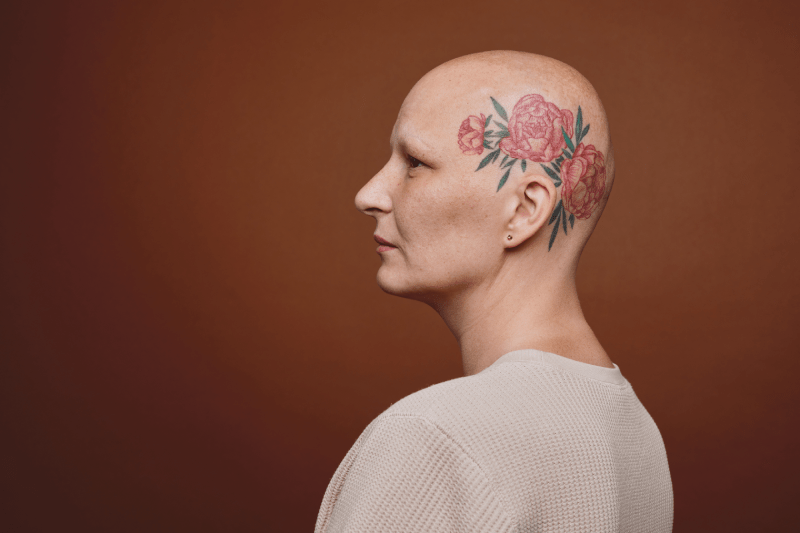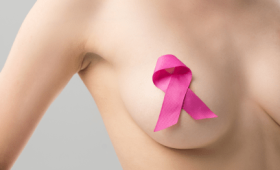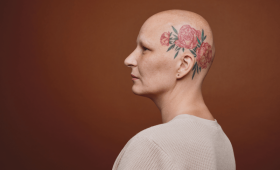Breast cancer is a disease that, when diagnosed early, significantly increases treatment success and survival rates. Being aware of changes in the body and adhering to regular screening programs are the most effective protection methods for women during this vital period.
Turkey offers diagnostic and treatment services at international standards with modern oncology centers, advanced imaging technologies, and expert healthcare professionals. This guide provides a detailed explanation of the first signs of breast cancer and early detection methods. You can also learn about the importance of early detection and diagnosis by reading our content.
What Is The Most Common First Symptom Of Breast Cancer?
The most common first symptom of breast cancer is generally a hard, painless lump or swelling felt in the breast or armpit. These lumps may be rounded, irregular, or immobile when touched. Although early-stage cancer lumps may be small, they create a noticeable change for the patient. While not every lump is cancer, every new formation noticed in the breast must absolutely be evaluated by a specialist physician. Performing monthly breast self-examination and tracking these changes is of great importance to catch the chance for early diagnosis.
Do Breast Lumps Always Mean Cancer?
No, the majority of lumps felt in the breast do not always mean cancer; on the contrary, most of the lumps are benign changes. These can often be fibroadenomas (hard, mobile lumps), cysts (fluid-filled sacs), or fibrocystic changes related to hormonal fluctuations. However, the nature of a lump cannot be determined solely by physical examination. Imaging methods such as mammography, ultrasound, and, if necessary, biopsy are required to make a definitive diagnosis. This differentiation prevents unnecessary anxiety for the patient and determines the correct treatment pathway.
In Which Situations Is Nipple Discharge A Cause For Concern?
Nipple discharge is concerning and may be a sign of cancer, especially if it comes from a single duct, is clear, red (bloody) or brown in color, and occurs spontaneously without any squeezing. Greenish or milky discharge is usually associated with hormonal imbalances or benign conditions. Bloody discharge can be a sign of serious conditions such as ductal carcinoma in situ (DCIS) or invasive cancer. Characteristics such as the nature, color of the discharge, and whether it comes from a single or both breasts are important clues that the physician will use in the diagnostic process.
What Does The Orange Peel Appearance Observed On Breast Skin Indicate?
The orange peel (Peau d’Orange) appearance observed on the breast skin, which results from the thickening of the skin and prominence of pores, is often an important sign of an aggressive type of breast cancer, such as Inflammatory Breast Cancer (IBC). This condition occurs due to the obstruction of lymphatic vessels in the skin by cancer cells. Unlike typical breast cancers, a lump may not be felt, but the condition can be accompanied by redness, increased warmth in the skin, and rapidly growing swelling. When such a condition is noticed, seeking immediate attention from an oncology specialist is of vital importance.
Can Feeling Pain In The Breast Be A Sign Of Cancer?
Feeling pain in the breast (mastalgia) is generally associated with hormonal changes, the menstrual cycle, cysts, or fibrocystic changes, rather than being a sign of cancer. Most breast cancer lumps are painless. However, if the breast pain is persistent, constantly increasing, or localized, especially if accompanied by a lump or skin changes, it requires further examination for the possibility of cancer. Although pain is a rare symptom of cancer, it can be seen, particularly in advanced stages or in inflammatory types. Therefore, persistent pains must always be taken into consideration.
Why Is Swelling In The Armpit Lymph Nodes Important?
Swelling in the armpit lymph nodes can be a normal immune response against an infection or inflammation in that region of the body, or it can be the first and important sign of breast cancer cells spreading (metastasis). Breast cancer tends to spread primarily to the lymph nodes in the armpit through the lymphatic system. The swelling is usually painless and firm. Therefore, even if there is no lump in the breast, persistent or growing swelling noticed in the armpit is critically important for a physician to examine for breast cancer screening and evaluation.
What Is The Most Effective Screening Method For Early Diagnosis?
The most effective and gold standard screening method for early diagnosis is mammography. Mammography has the ability to detect very small lumps or calcifications in breast tissue at an early stage, before they can be felt manually. Experts generally recommend regular mammography screening once a year starting from the age of 40. Regular mammography screenings have a proven effect in reducing deaths from breast cancer, as the chance of treatment and success is highest when the disease is caught at a very early stage.
At What Age Should Mammography Start And How Often Should It Be Done?
According to generally accepted guidelines, women are recommended to start mammography screenings at the age of 40 and have it done once a year. For women in the high-risk group (those with a family history of early-age cancer or carrying a gene mutation), screening may need to start at an earlier age (e.g., from age 30) and at more frequent intervals, sometimes combined with MRI. The frequency of screening should be determined based on personal risk factors and the physician’s assessment; this individualized approach yields the most accurate result.
Why Is Mammography Vital For The Early Diagnosis Of Breast Cancer?
Mammography is vital for the early diagnosis of breast cancer because it can detect millimetric lumps and especially clusters of microcalcifications that cannot be felt manually. Microcalcifications can be the first sign of certain early cancer types, such as ductal carcinoma in situ (DCIS). This allows cancer to be detected and treated before it becomes invasive and before the risk of spreading to the lymph nodes occurs. This early intervention preserves surgical options and significantly increases the patient’s life expectancy.
Is Breast Ultrasound An Alternative To Mammography?
Breast ultrasound is generally not an alternative but a complementary imaging method to mammography. Ultrasound is used, especially in young women and patients with dense breast tissue, in situations where mammography struggles to visualize the lump. Ultrasound is very successful in distinguishing whether a lump is solid or a fluid-filled cyst. However, it is not recommended as a standalone screening method. It is usually added to examine a suspicious finding on mammography in more detail, or for screening purposes in high-risk young women, as high-risk individuals have a high probability of developing cancer.

To Whom Is Breast Magnetic Resonance Imaging (MRI) Recommended?
Breast Magnetic Resonance Imaging (MRI) is a very sensitive screening method recommended for specific patients in the high-risk group. This group includes those carrying BRCA1/2 gene mutations, those with a strong family history of cancer, and individuals who have received radiation therapy to the chest area before the age of 30. Due to its high sensitivity, MRI can detect breast cancer at an early stage and is usually used in conjunction with mammography. It can also be considered in women with dense breasts and those with breast implants as an addition to mammography, as it significantly increases cancer risk in high-risk individuals.
How Is Breast Self-Examination Done Correctly?
Breast self-examination (BSE) is a simple practice that every woman should perform once a month, a few days after the menstrual period ends (when the breasts are least tender). The examination includes steps such as observing the shape and skin changes of the breasts in front of a mirror, and gently checking the breasts and armpits with fingertips in circular movements, either standing up or in the shower. The goal is to recognize the normal tissue of the breasts and to timely notice any new changes such as a lump, thickening, dimpling, or discharge.
Does The Importance Of Breast Self-Examination Still Exist?
Yes, despite the increasing prevalence of professional screening methods like mammography and ultrasound, the importance of breast self-examination still persists. BSE allows the woman to recognize her own breast tissue and offers the chance for early detection of rapid changes that might occur between two screening appointments. It is a critical step, especially in young women who have not yet reached the age for mammography, as it increases breast health awareness. However, it should be remembered that BSE can never replace regular professional screening and clinical examination.
Does The Biopsy Procedure Confirm Breast Cancer?
The biopsy procedure is the only method that confirms the diagnosis of breast cancer. While imaging tests (mammography, ultrasound) only show the presence of a lump or a suspicious area, a small tissue sample is taken from this area with a biopsy. The obtained tissue is examined under a microscope by pathologists to definitively determine vital information such as the presence of cancer cells, the type (ductal, lobular), grade, and hormone receptor status. This definitive diagnosis serves as the basis for oncology specialists to create the most appropriate treatment plan.
What Are The Types Of Needle Biopsy And How Are They Selected?
Needle biopsy has various types used to take samples from a suspicious breast lump. The main types are Fine-Needle Aspiration Biopsy (FNAB), Core Needle Biopsy (Tru-Cut), and vacuum-assisted biopsy systems. FNAB is usually used for the differential diagnosis of cysts, while core needle biopsy is the standard method preferred for definitive cancer diagnosis and determining the tumor’s biological characteristics (receptor status). Vacuum-assisted biopsy allows for obtaining more tissue samples from very small lesions or areas with microcalcifications.
What Are The Risk Factors And Who Should Be Followed More Closely?
Risk factors for breast cancer include increasing age, a family history of breast cancer, carrying the BRCA gene mutation, early onset of menstruation, late menopause, never having given birth or giving birth at an advanced age, dense breast tissue, exposure to radiation, and long-term hormone therapy use. Individuals with any of these factors are in a higher risk group than the general population and should be enrolled in a more intensive and earlier-starting follow-up program including mammography, MRI, and clinical examinations.
How Does A Family History Of Breast Cancer Increase The Risk Rate?
A family history of breast cancer significantly increases an individual’s risk, especially if diagnosed in first-degree relatives (mother, sister, daughter) and at a young age (pre-menopause). The risk can double if a first-degree relative has breast cancer. The risk increases even further if multiple relatives are affected or if there is a history of ovarian cancer in relatives. Therefore, these individuals should seek genetic counseling and consider starting screenings 10 years earlier than the standard age.
What Do BRCA1 And BRCA2 Gene Mutations Mean?
BRCA1 and BRCA2 gene mutations are hereditary genetic changes that dramatically increase the risk of breast and ovarian cancer. These genes normally repair cell damage and prevent cancer; but when mutated, this protective function is impaired. Carrying a BRCA mutation can increase the lifetime risk of breast cancer between 40% and 85%. Individuals carrying these mutations are offered preventive options such as intensive surveillance programs, chemopreventive drugs, and even prophylactic (preventive) surgery (mastectomy).
Does Hormone Replacement Therapy Increase The Risk Of Breast Cancer?
Yes, Hormone Replacement Therapy (HRT) can slightly increase the risk of breast cancer, especially when combined estrogen and progesterone are used for a long time (more than 5 years). The risk increases with the duration of treatment and higher hormone doses, but the risk begins to decrease once the treatment is stopped. Women considering HRT to alleviate menopausal symptoms should thoroughly discuss the potential benefits versus the breast cancer risk with their doctor and use the lowest effective dose for the shortest duration possible.
How Do Early Menstruation And Late Menopause Affect The Risk?
Early onset of menstruation (before age 12) and late menopause (after age 55) mean that a woman is exposed to hormones that cause breast cancer for a longer period throughout her life. This slightly increases the risk of breast cancer. Because when breast cells are under the influence of hormones like estrogen for a longer time, their likelihood of becoming cancerous increases. Since these conditions are unchangeable risk factors, these women need to pay extra attention to regular screening and clinical examination follow-up, especially after the age of 40.
Do Lifestyle Changes Reduce The Risk Of Breast Cancer?
Absolutely yes. Lifestyle changes play a major role in reducing the risk of breast cancer, especially in individuals without genetic predisposition. These changes include maintaining an ideal body weight, engaging in regular physical activity, limiting alcohol consumption (preferably eliminating it), and adopting a diet low in saturated fats and rich in fiber. A healthy lifestyle helps to slow down cancer development by maintaining hormonal balance and reducing chronic inflammation. This active approach increases the individual’s control over their health.

Does Regular Exercise Have A Protective Effect?
Yes, regular physical activity has been scientifically proven to reduce the risk of breast cancer. Performing at least 150 minutes of moderate-intensity aerobic exercise (brisk walking, running, etc.) or 75 minutes of high-intensity exercise per week demonstrates a protective effect. Exercise lowers estrogen levels by reducing body fat percentage, improves insulin resistance, and strengthens immune system functions. These metabolic and hormonal adjustments significantly reduce the cancer risk by suppressing the growth environment for cancer cells.
What Is The Relationship Between Excess Weight Or Obesity And Breast Cancer?
Excess weight or obesity significantly increases the risk of breast cancer, especially in post-menopausal women. The reason for this is that after menopause, estrogen production is primarily performed by fat tissue (adipose tissue). The more fat tissue in the body, the more estrogen is produced. This excess estrogen can trigger the uncontrolled growth of breast cells. Therefore, maintaining a healthy weight, particularly after the menopause period, forms a critical defense line against breast cancer and also supports treatment success.
How Does Alcohol Consumption Affect The Risk Of Breast Cancer?
Alcohol consumption is a factor that directly increases the risk of breast cancer as the amount consumed increases. Alcohol contributes to cancer development by raising estrogen levels and impairing the ability of breast cells to repair DNA damage. Experts recommend limiting alcohol consumption to one drink (unit) per day or less, or even avoiding it completely, to reduce the risk of breast cancer. This risk increase becomes more pronounced with regular and continuous alcohol intake and requires greater caution in individuals with genetic predisposition.
What Is The Relationship Between Early Diagnosis And Treatment Success?
The relationship between early diagnosis and treatment success is directly proportional and vital. When cancer is caught while still small, before it has spread to the lymph nodes or other parts of the body (Stage I), the chance of complete cure and the 5-year survival rates exceed 90%. Early diagnosis allows for surgical options (such as breast-conserving surgery) and may require less intensive chemotherapy. Delayed diagnosis leads to the spread of cancer throughout the body, making treatment much more complex and difficult.
What Steps Are Taken After Breast Cancer Diagnosis?
The first steps taken after a definitive breast cancer diagnosis are to determine the stage of the tumor (with PET-CT or other imaging), analyze its biological characteristics (Hormone Receptors, HER2 status), and evaluate the patient’s general health status. In light of this information, a personalized treatment plan consisting of a combination of surgery, chemotherapy, radiotherapy, hormone therapy, or targeted therapy is created by an oncology board (multidisciplinary board). Preparation for the patient’s psychological support and adherence to the treatment is made before starting treatment.
How Does Tumor Size Affect The Diagnosis Process?
Tumor size directly affects the cancer’s stage and consequently the treatment approach. Small tumors detected by mammography or ultrasound generally indicate an early stage (Stage I) and typically have a high chance of complete cure with surgery alone. Larger tumors increase the risk of spread to the lymph nodes and may often require neoadjuvant (pre-operative) chemotherapy to shrink the tumor before surgery. Tumor size provides important information about the treatment plan and prognosis, serving as a guide for doctors.
What Is Triple Negative Breast Cancer And Why Is It Difficult?
Triple Negative Breast Cancer (TNBC) is one of the most aggressive types of breast cancer and is difficult to treat because it is negative for Estrogen Receptor (ER), Progesterone Receptor (PR), and HER2 protein. This means that TNBC cannot be treated with standard hormone therapy or smart drugs targeting HER2. Its treatment primarily relies on chemotherapy and immunotherapy combinations. It is relatively more common in young women and BRCA mutation carriers. Its difficulty stems from its tendency to recur quickly and the limited targeted options available.
How Are Hormone Receptor Positive Cancers Treated?
Hormone Receptor Positive (ER+/PR+) cancers are the most common subtype of breast cancer and generally have a good prognosis. The treatment of these tumors is done with hormone therapy (anti-estrogen drugs) which block the hormone (estrogen and/or progesterone) that cancer cells need for growth or stop its production. Hormone therapy, usually lasting 5 to 10 years after surgery and radiotherapy, significantly reduces the risk of relapse. In some cases, new-generation smart drugs like CDK4/6 inhibitors are added to hormone therapy to enhance treatment efficacy.
When Is Sentinel Lymph Node Biopsy Performed?
Sentinel Lymph Node Biopsy is performed during surgery when breast cancer is diagnosed and there is no clear suspicion of spread to the armpit lymph nodes. In this procedure, the 1-3 lymph nodes closest to the tumor, which are the first potential sites of cancer spread, are removed and examined pathologically. If no cancer cells are found in these sentinel nodes, there is no need to remove the other lymph nodes (axillary dissection), which is a protective approach that greatly reduces the risk of arm swelling (lymphedema) in the patient.
What Do False Negative Mammography Results Mean?
False negative mammography results mean that cancer is actually present despite the mammography being performed, but the device failed to detect it. The most common reasons for this are dense breast tissue (especially in young women), the cancer mass being small, slow growth, or the tumor being obscured by surrounding tissue. Since false negative results can create a false sense of security, the use of complementary imaging methods such as ultrasound or MRI in addition to mammography in at-risk patients is vital.
Is Mammography Sufficient For Women With Dense Breasts?
No, mammography alone is generally not sufficient for women with dense (radiologically white) breasts. Since dense breast tissue appears white on radiology, cancer lumps can be hidden (masking effect) within this white tissue. This situation lowers the cancer detection rate. Therefore, it is recommended that women with dense breasts undergo breast ultrasound or, if at high risk, Breast MRI as additional screening methods alongside mammography. This combined approach significantly increases the success of early diagnosis and reduces the chance of missing cancer.
What Are The Symptoms Of Advanced Breast Cancer?
The symptoms of advanced (metastatic) breast cancer vary depending on the organ to which the cancer has spread. The most common areas of spread are bones, lungs, liver, and brain. Symptoms may include persistent bone pain, chronic cough or shortness of breath, jaundice in the skin or eyes, severe and persistent headaches, or neurological changes. These conditions indicate the fourth stage of the disease, and treatment focuses on controlling the disease to alleviate symptoms and preserve the quality of life.
Can Breast Cancer Be Diagnosed During Pregnancy?
Yes, breast cancer can be diagnosed during pregnancy, but this is rare, and the diagnosis may be delayed. Because the natural swelling and tenderness in the breasts during pregnancy make it difficult to notice lumps. When a diagnosis is made during pregnancy, the treatment plan is specially tailored to protect both the mother’s and the baby’s health. Surgery and certain types of chemotherapy can be safely administered, while radiotherapy and some hormonal treatments are usually postponed until after birth. It is important to monitor changes in the breast even during pregnancy for early diagnosis.

What Are The Symptoms Of Breast Cancer In Men And Is It Rare?
Breast cancer in men is very rare, accounting for less than 1% of all breast cancer cases. However, the diagnosis in men is usually made later than in women. The most common symptom is a firm, painless lump felt just behind the nipple. Other symptoms may include nipple retraction, redness or ulceration of the skin, and discharge from the nipple (especially bloody). Men with a strong family history of breast cancer or carrying the BRCA gene mutation are also at risk, and awareness is important.
Why Should A Health Tourism Center Be Preferred For Cancer Treatment In Turkey?
Turkey is a globally recognized center in the field of health tourism, especially for complex treatments such as oncology and stem cell transplantation. Hospitals equipped with advanced technology have international accreditations and offer access to the most up-to-date treatments (immunotherapy, targeted therapies). The fact that high-quality treatment can be received at much more affordable costs compared to Western countries, and that support services like translation and accommodation are comprehensive, makes Turkey attractive to international patients. This allows patients to find economic solutions without sacrificing the quality of treatment.
What Are The Emotional Coping Mechanisms After Cancer Diagnosis?
A cancer diagnosis creates intense emotional stress; however, there are effective ways to cope with this process. The most important is seeking psychological support (individual therapy or support groups) and expressing emotions healthily instead of suppressing them. Patients can reduce uncertainty by getting information about their treatment plans, apply stress-reducing techniques such as yoga or meditation, and maintain physical activities (to the extent possible) to preserve their energy levels. The support of family and friends is also vitally important in this process.
Is Pain During Mammography Normal And How Can It Be Reduced?
Short-term pain or discomfort caused by the compression of the breasts during mammography is normal, but it usually does not last longer than a few seconds. To reduce the pain, it is recommended to schedule the mammography appointment in the first week after the menstrual period ends (when the breasts are least tender). Additionally, taking a mild pain reliever an hour before the appointment or informing the technician about their sensitivity can make the process more comfortable. Although compression is necessary for image quality, the technician’s gentle approach is important.
How Does Breast Cancer Progress If Early Diagnosis Is Not Made?
If early diagnosis is not made, breast cancer progresses through the growth of the tumor and its spread, first to the armpit lymph nodes, and then via the bloodstream to distant organs (bone, lung, liver, brain). This stage, known as metastatic disease, makes treatment much more challenging and generally palliative, meaning the chance of complete cure decreases. This progression leads to the worsening of symptoms and a serious decline in the patient’s quality of life. Therefore, regular screening and early intervention are life-saving.
To Whom Is Breast-Conserving Surgery (Lumpectomy) Applied?
Breast-Conserving Surgery (Lumpectomy) is applied to patients with early-stage, small-sized tumors where the cosmetic appearance of the remaining breast tissue can be preserved. This surgery involves only the removal of the tumor and a small amount of surrounding healthy tissue. Radiotherapy must absolutely be applied after Lumpectomy to reduce the risk of relapse. This method is an important option that supports the patient’s psychological health and quality of life by preserving breast integrity compared to mastectomy.
What Is The Role Of Integrative Medicine In Cancer Treatment?
Integrative medicine in cancer treatment involves the use of evidence-based complementary therapies (acupuncture, meditation, nutritional counseling, massage) to support traditional oncology treatments (chemotherapy, radiotherapy). The goal of these therapies is not to treat the cancer, but to reduce side effects related to treatment (nausea, fatigue, pain) and improve the patient’s overall quality of life. It should be seen as an inseparable part of the treatment plan and always applied with the approval of the oncology team.
What Is Lymphedema In Breast Cancer And How Is It Prevented?
Lymphedema is the chronic swelling that occurs in the arm, chest, or shoulder after breast cancer surgery or radiotherapy, resulting from damage or removal of the lymph nodes in the armpit. Lymphedema is a painful and uncomfortable condition that can last a lifetime. To prevent it, prioritizing sentinel lymph node biopsy, avoiding extensive lymph node dissection, and applying special exercises, compression garments, and manual drainage massage in the early post-operative period are critically important. Careful and continuous follow-up of at-risk patients is necessary.
Is Breast Cancer Diagnosis At A Young Age More Aggressive?
Yes, cases of breast cancer diagnosed at a young age (especially under 40) tend to be more aggressive and higher-grade tumors compared to those diagnosed after menopause. Young-age cancers can frequently have more challenging subtypes such as Triple Negative or HER2 positive and may grow faster. Therefore, treatment in young patients usually involves more intensive chemotherapy and radiotherapy regimens. Young women are advised to pay more attention to their family history and start screenings at an earlier age if risk factors are present.
What Are The Five Most Important Steps To Prevent Breast Cancer?
The five most important steps to take to prevent breast cancer are: 1. Regular Mammography Screening: Having an annual mammogram from the age of 40. 2. Maintaining a Healthy Body Weight: Preventing weight gain, especially in the post-menopausal period. 3. Regular Physical Activity: Exercising at a moderate level for at least 150 minutes per week. 4. Limiting Alcohol Consumption: Keeping alcohol consumption to a minimum or eliminating it entirely. 5. Self-Examination and Awareness: Tracking every change in the breast and immediately consulting a physician in case of suspicion.
In this challenging process, correct information and expert support are of vital importance. To reach Turkey’s expert physicians and advanced technology centers for breast cancer and other serious health issues, to receive personalized treatment and professional health tourism services, you can contact Cure Holiday. Taking confident steps on your health journey and evaluating the most current options in Turkey for your treatment means investing in a healthy future.


